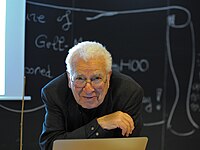Down quark
ħ | |
|---|---|
| Weak isospin | LH: −1/2, RH: 0 |
| Weak hypercharge | LH: +1/3, RH: −2/3 |
The down quark (symbol: d) is a type of
The down quark is part of the
Its existence (along with that of the up and
History


In the beginnings of particle physics (first half of the 20th century),
This classification scheme organized the hadrons into
At first people were reluctant to identify the three-bodies as quarks, instead preferring
Mass
Despite being extremely common, the bare mass of the down quark is not well determined, but probably lies between 4.5 and 5.3 MeV/c2.[15] Lattice QCD calculations give a more precise value: 4.79±0.16 MeV/c2.[16]
When found in mesons (particles made of one quark and one antiquark) or baryons (particles made of three quarks), the 'effective mass' (or 'dressed' mass) of quarks becomes greater because of the binding energy caused by the gluon field between quarks (see mass–energy equivalence). For example, the effective mass of down quarks in a proton is around 300 MeV/c2. Because the bare mass of down quarks is so small, it cannot be straightforwardly calculated because relativistic effects have to be taken into account,
References
- ^ a b
M. Tanabashi et al. (Particle Data Group) (2018). "Review of Particle Physics". Physical Review D. 98 (3): 1–708. PMID 10020536.
- ^
M. Gell-Mann (2000) [1964]. "The Eightfold Way: A theory of strong interaction symmetry". In M. Gell-Mann, Y. Ne'eman (ed.). The Eightfold Way. ISBN 978-0-7382-0299-0..
Original: M. Gell-Mann (1961). "The Eightfold Way: A theory of strong interaction symmetry". Synchrotron Laboratory Report CTSL-20. California Institute of Technology - ^ Y. Ne'eman (2000) [1964]. "Derivation of strong interactions from gauge invariance". In M. Gell-Mann, Y. Ne'eman (ed.). The Eightfold Way. .
- ^ M. Gell-Mann (1964). "A Schematic Model of Baryons and Mesons". .
- ^ G. Zweig (1964). "An SU(3) Model for Strong Interaction Symmetry and its Breaking". CERN Report No.8181/Th 8419.
- ^ G. Zweig (1964). "An SU(3) Model for Strong Interaction Symmetry and its Breaking: II". CERN Report No.8419/Th 8412.
- ^ B. Carithers, P. Grannis (1995). "Discovery of the Top Quark" (PDF). Beam Line. 25 (3): 4–16. Retrieved 2008-09-23.
- ^ E. D. Bloom; et al. (1969). "High-Energy Inelastic e–p Scattering at 6° and 10°". .
- ^
M. Breidenbach; et al. (1969). "Observed Behavior of Highly Inelastic Electron–Proton Scattering" (PDF). S2CID 2575595.
- ^
J. I. Friedman. "The Road to the Nobel Prize". Hue University. Archived from the originalon 2008-12-25. Retrieved 2008-09-29.
- ^ R. P. Feynman (1969). "Very High-Energy Collisions of Hadrons" (PDF). .
- ^
S. Kretzer; H. Lai; F. Olness; W. Tung (2004). "CTEQ6 Parton Distributions with Heavy Quark Mass Effects". S2CID 119379329.
- ^
D. J. Griffiths (1987). Introduction to Elementary Particles. ISBN 978-0-471-60386-3.
- ^
M. E. Peskin, D. V. Schroeder (1995). An introduction to quantum field theory. ISBN 978-0-201-50397-5.
- ^ J. Beringer; et al. (Particle Data Group) (2013). "PDGLive Particle Summary 'Quarks (u, d, s, c, b, t, b′, t′, Free)'" (PDF). Particle Data Group. Retrieved 2013-07-23.
- ^ Cho, Adrian (April 2010). "Mass of the Common Quark Finally Nailed Down". Science Magazine. Archived from the original on 2012-03-06.
Further reading
- A. Ali, G. Kramer; Kramer (2011). "JETS and QCD: A historical review of the discovery of the quark and gluon jets and its impact on QCD". S2CID 54062126.
- R. Nave. "Quarks". HyperPhysics. Georgia State University, Department of Physics and Astronomy. Retrieved 2008-06-29.
- A. Pickering (1984). Constructing Quarks. ISBN 978-0-226-66799-7.
